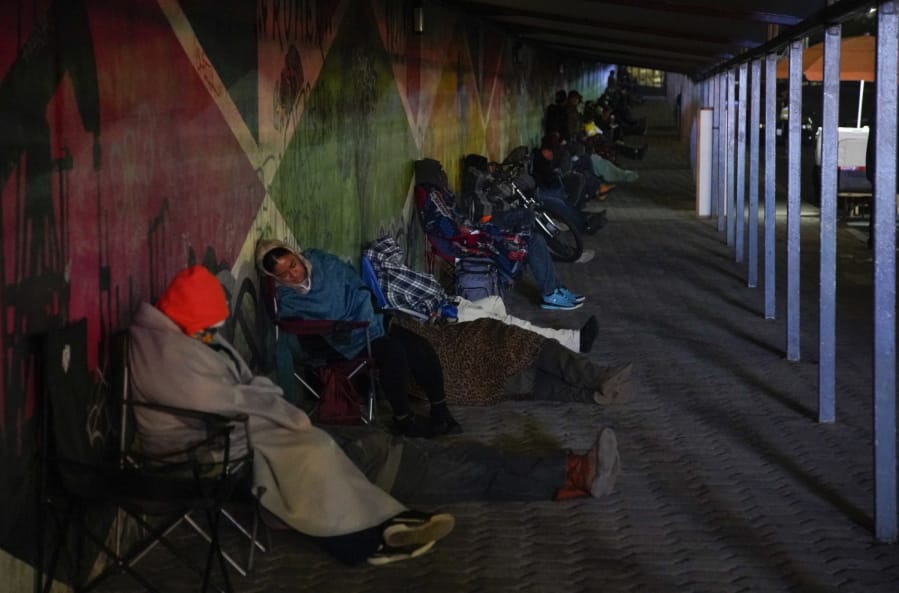TIJUANA, Mexico — Dozens of cross-border workers are sleeping on the sidewalk or inside their cars to be among the first enter the United States once the Otay Mesa Port of Entry opens each morning.
The scene has played out ever since this busy border crossing, which previously operated 24 hours a day, temporarily suspended operations at night.
Being late to work isn’t an option for these workers, so they prefer a bad sleepover to the unpredictable wait times at the other port of entry in San Ysidro.
Since the beginning of May, the Otay Mesa Port of Entry has been operating from 6 a.m. to 10 p.m. The reduction in hours comes as restrictions against nonessential travel at the border have decreased northbound traffic.
That has pushed nighttime and early morning border traffic in the Tijuana-San Diego region to the San Ysidro port of entry, which remains open 24 hours, although it has been operating with fewer lanes for several weeks now.
Some workers tried to shift from Otay Mesa to San Ysidro but encountered longer wait times.
“We cannot rely on border wait times,” said Porfirio Perez, a mechanic who works in a San Diego.
So he arrived at the Otay Mesa Port of Entry at 10:30 p.m. on Thursday night, parked in one of the lanes, and slept inside his car. He has been doing the same thing for three weeks now, and he is getting tired. “It’s stressful, we barely get any sleep,” he said.
Julio Quintero did the same thing the night before to be on time for work in Chula Vista.
He knows the drill by now. He only carries a blanket, set up the alarm and sleeps in the back of his car. At his work in a flower shop, they give him a chance to be half an hour late because they know the current border situation.
He once tried to cross through San Ysidro, but the line seemed endless, he said. It’s better to at least to have some sleep than spend the night in line wasting gas, he reasoned. “It’s very tiring, but what else can we do?” asked Quintero.
Other workers who live near the Otay Mesa Port of Entry prefer to park their cars at night in the line, go home to sleep and return to them minutes before the port opens at 6 a.m. But Quintero says he does not think that is a good idea.
At the pedestrian crossing, dozens sleep either in folding chairs or in the sidewalk covered by blankets.
Javier Sanchez, a construction worker, adopted this routine last week and said the most tiring part is not knowing how long it would take to get everything back to normal.
The U.S. and Mexican governments agreed this past week to extend once again the border travel restrictions through at least June 22.
The border crossings are open for U.S. citizens, legal permanent residents, people with work visas, and those traveling for education or medical reasons, among other reasons deemed essential. Crossings remain closed for recreational and tourist travel.
Gustavo de la Fuente, executive director of the Smart Border Coalition, said he believes U.S. authorities should monitor the wait times as economic activities reopen.
“Just as businesses keep reopening or accepting more employees inside their facilities in San Diego, the border wait times will continue to increase,” he estimates.
U.S. Customs and Border Protection acknowledged that travelers may face increased wait times in passenger and commercial operations due to restricted crossings and temporary closures of processing lanes.
“We monitor and make operational adjustments daily, depending on the totality of the workload we have at each port. While the non-essential travel restrictions are in place, we are focused on maintaining wait times for workers crossing during the weekday morning peak hours similar to what they were before the restrictions came into effect,” the agency said in a statement.
In the meantime, some cross-border workers consider other options.
David Ramos, who works at a veterans’ home in San Diego, prefers to cross through San Ysidro at night and sleep on the other side of the border.
“I don’t see the point of staying a few feet away from the port of entry when you can cross at night and sleep at or near your work,” he said.
Meanwhile, mornings have taken on a new routine at the Otay Mesa border.
The sound of cellphone alarms start ringing around 5:30 a.m.
By 5:55 a.m., car engines are turned on and pedestrians get ready with their documents.
And at 6 a.m., dozens of workers begin to move knowing that — at least for now — they will have to do this all over again.
——
(C)2020 The San Diego Union-Tribune
Visit The San Diego Union-Tribune at www.sandiegouniontribune.com
Distributed by Tribune Content Agency, LLC.
———-
PHOTO (for help with images, contact 312-222-4194):



